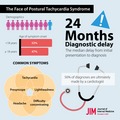- Record: found
- Abstract: found
- Article: found
The face of postural tachycardia syndrome – insights from a large cross‐sectional online community‐based survey
Read this article at
Abstract
Background
Patients with postural tachycardia syndrome ( POTS) experience chronic symptoms of orthostatic intolerance. There are minimal data detailing the demographics, clinical features and clinical course of this condition. This online, community‐based survey highlights patients’ experience with POTS. It consists of the largest sample of POTS patients reported to date.
Objectives
To describe the demographics, past medical history, medications, treatments and diagnostic journey for patients living with POTS.
Methods
Postural tachycardia syndrome patients completed an online, community‐based, cross‐sectional survey. Participants were excluded if they had not received a diagnosis of POTS from a physician. The questions focused on the patient experience and journey, rather than physiological responses.
Results
The final analysis included 4835 participants. POTS predominantly affects white (93%) females (94%) of childbearing age, with approximately half developing symptoms in adolescence (mode 14 years). POTS is a chronic multisystem disorder involving a broad array of symptoms, with many patients diagnosed with comorbidities in addition to POTS. POTS patients often experience lengthy delays [median (interquartile range) 24 (6–72) months] and misdiagnosis, but the diagnostic delay is improving. POTS patients can present with a myriad of symptoms most commonly including lightheadedness (99%), tachycardia (97%), presyncope (94%), headache (94%) and difficulty concentrating (94%).
Conclusions
These data provide important insights into the background, clinical features and diagnostic journey of patients suffering from POTS. These data should serve as an essential step for moving forward with future studies aimed at early and accurate diagnoses of these patients leading to appropriate treatments for their symptoms.
Abstract
Related collections
Most cited references35
- Record: found
- Abstract: found
- Article: not found
Global prevalence of and risk factors for irritable bowel syndrome: a meta-analysis.
- Record: found
- Abstract: not found
- Article: not found
Consensus statement on the definition of orthostatic hypotension, neurally mediated syncope and the postural tachycardia syndrome.
- Record: found
- Abstract: not found
- Article: not found
